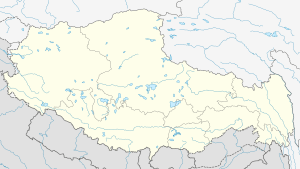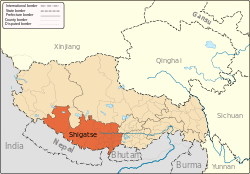Gyirong County
| Gyirong County 吉隆县 • སྐྱིད་གྲོང་རྫོང་། | |
|---|---|
| County | |
|
| |
.png) Location of Gyirong County (red) within Xigazê City (yellow) and the Tibet Autonomous Region | |
 Gyirong Location of the seat in the Tibet Autonomous Region | |
| Coordinates: 28°51′16″N 85°17′48″E / 28.85444°N 85.29667°ECoordinates: 28°51′16″N 85°17′48″E / 28.85444°N 85.29667°E | |
| Country | People's Republic of China |
| Autonomous region | Tibet Autonomous Region |
| Prefecture-level city | Xigazê |
| Seat | Zongga |
| Time zone | UTC+8 (China Standard) |
sKyid-grong (Gyirong, Kyirong, Tibetan: སྐྱིད་གྲོང་རྫོང་།, Wylie: skyid grong rdzong, ZYPY: Gyirong Zong ; Chinese: 吉隆县; pinyin: Jílóng Xiàn) is a former district (རྫོང་, rDzong) in the south-west of Tibet and is from 1960 onwards a county of the newly established Xigazê of the newly established Tibet Autonomous Region. It is famous because of its mild climatically conditions and its abundant vegetation which is unusual for the Tibetan plateau. The capital lies at Zongga. Its name in Tibetan, Dzongka means "mud walls".
It is one of the four counties that comprise the Qomolangma National Nature Preserve (Gyirong, Dinggyê, Nyalam, and Tingri).[1]
In 1945 Peter Aufschnaiter counted 26 temples and monasteries which covered the area of sKyid-grong and the neighboring La-sdebs. The most famous temple of sKyid-grong is the Byams-sprin lha-khang, erected by the famous Tibetan king Srong-btsan sgam-po (Songtsän Gampo) as one of the four Yang-´dul temples in the 7th century A.D. During the 11th century the famous Indian scholar Atisha visited sKyi-grong. sKyid-grong was one of the favorite meditation places of the Tibetan Yogin Mi-la ras-pa (Milarepa).
The local dialect of sKyid-grong has been researched thoroughly and folk literature of this region was collected and published during the 1980s.
Special places
Of outstanding importance are the Byams-sprin lha-khang temple, which was built in the 7th century A. D., and the ´Phags-pa lha-khang temple. The ´Phags-pa lha-khang formerly contained one of the holiest Avalokiteshvara statues of Tibet, the statue of the Ārya Va-ti bzang-po. This statue was brought to India in 1959 and is now kept in Dharamsala.
Of some importance is the bKra-shis bdam-gtan gling monastery, founded by yongs-´dzin Ye-shes rgyal-mtshan (1713–1793), who was one of the teachers of the 8th Dalai Lama.
Lake Paiku is in this county. This is a 27 km (17 mi) long, slightly salty lake surrounded by snowy peaks 5,700 to 6,000 m (18,700 to 19,700 ft) high.
Towns and townships
- Zongga Town (རྫོང་དགའ་, 宗嘎镇)
- Gyirong Town (སྐྱིད་གྲོང་, 吉隆镇)
- Zhêba Township (ཀྲེ་པ་, 折巴乡)
- Kungtang Township(གུང་ཐང་, 贡当乡)
- Chagna Township (བྲག་སྣ་, 差那乡)
Transportation
Up to 1960 one of the main trade routes between Nepal and Tibet passed through this region. Easily accessible from Nepal, it was used several times as an entrance gate for military actions from the site of Nepal against Tibet. In 2017, Chinese soldiers began building a new road on the Tibetan side of the border, and intend to continue construction into Nepal pending approval from Kathmandu.[2]
Notes
- ↑ Department of Forestry, Government of the Tibet Autonomous Region, People’s Republic of China, ‘’Report on Protected Lands in the Tibet Autonomous Region’’ Lhasa: Tibet Autonomous Region Government Publishing House, 2006
- ↑ Lhuboom; Richard Finney (September 8, 2017). "China Builds Road to Nepal Border, Sets Up Flag". Translated by Damdul, Dorjee. Radio Free Asia.
The group, which appeared on Sept. 1 at Nepal’s border with Kyirong county in the Tibet Autonomous Region, distributed food and clothing to the Nepalese, promising to help them with the roadwork and other construction projects in Nepal if permission can be obtained from government authorities in Kathmandu, a resident of the area told RFA’s Tibetan Service.
References
- Roland Bielmeier, Silke Herrmann: Märchen, Sagen und Schwänke vom Dach der Welt. Tibetisches Erzählgut in Deutscher Fassung, Band 3. Viehzüchtererzählungen sowie Erzählgut aus sKyid-grong und Ding-ri, gesammelt und ins Deutsche übertragen. Vereinigung für Geschichtswissenschaft Hochasiens Wissenschaftsverlag (= Beiträge zur tibetischen Erzählforschung, 3), Sankt Augustin 1982
- Harrer, Heinrich: Seven Years in Tibet; Beyond Seven Years in Tibet: My Life Before, During, and After (2007)
- Aufschnaiter, Peter: Land and Places of Milarepa. East and West, 26 (1976):1-2, S. 175-189
- Brauen, Martin: Heinrich Harrers Impressionen aus Tibet. Innsbruck, 1974
- Brauen, Martin: Peter Aufschnaiter. Sein Leben in Tibet. Innsbruck, 1983
- Ehrhard, Franz-Karl: Die Statue des Ārya Va-ti bzang-po. Wiesbaden, 2004
- Huber, Brigitte: The Tibetan Dialect of Lende (Kyi-rong): a grammatical description with historical annotations. Bonn, 2005
- Dieter Schuh: Das Archiv des Klosters bKra-shis bsam-gtan gling von sKyid-grong. Bonn, 1988
